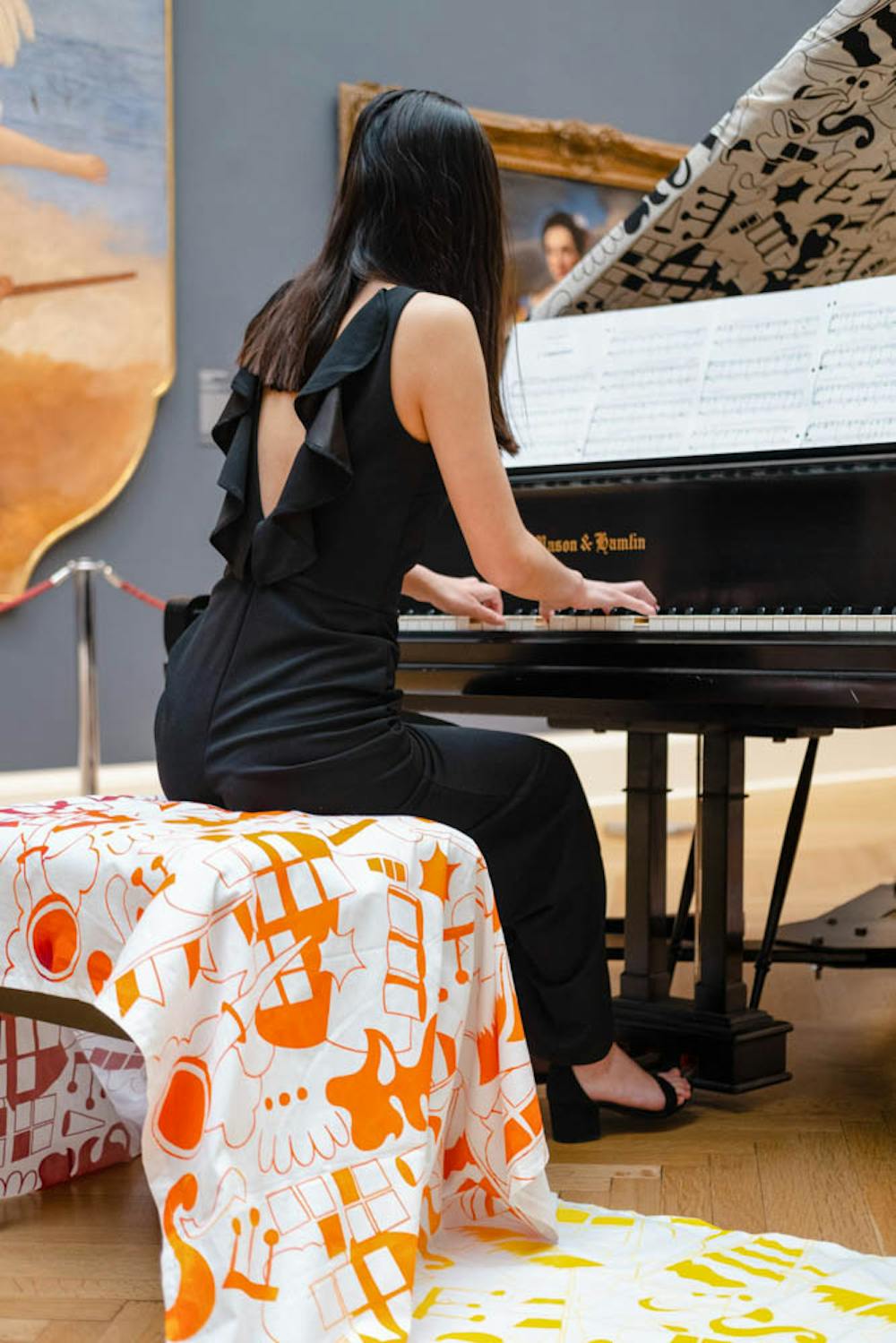Overcast light filtered into the Rhode Island School of Design Museum’s Grand Gallery on Saturday afternoon to illuminate an interdisciplinary and contemplative performance by the Muse Initiative.
The Feb. 8 performance, “Muse: Satie Reimagined,” was the inaugural event of the initiative founded by Herald staff writer Claire Liu ’23 and former contributing writer Naya Lee Chang ’24. Muse seeks to reinvigorate the longstanding historical tradition of integrative artistic practice, with particular emphasis on filling the modern gaps between visual arts and musical composition, Liu explained.
As an intimate crowd filtered into the gallery adorned with traditional portraits this past Saturday, the two first-year students saw their artistic vision brought to life. Chang explained that she wanted to shatter the conception of “museums as stagnant, dead places where you stand and look at paintings on walls.”
As the audience quieted, Liu took to the piano to play Erik Satie’s “3 Gymnopédies,” which steadily built in the atmosphere’s emotionality. While Liu played Satie’s chords with intention and personality, Chang began to unfold the visual element of their performance: graphic, Cubist-inspired textiles created in her RISD Wintersession course this past term.
Because Satie, a French avant-garde composer, worked closely alongside Cubist visual artists during his lifetime, Chang sought to echo similar elements of temporality and vibrancy in her textiles, she said.
The fabrics were most directly inspired by the ballet “Parade,” which features costumes by Picasso and music composed by Satie. This collaborative, historical event worked as a canon for the community-based art Muse seeks to promote, Chang said.
Chang’s textiles covered the piano, creating a vibrant “costume” for Liu’s musical performance. The fabrics varied from brightly colored satins to quieter chiffons — each of them decorated with musical motifs in a loose homage to the Cubist style.
In the second set, Liu played Satie’s Gnossiennes 1, 2 and 3, offering a personal interpretation of the late 19th century compositions. Liu reflected that in selecting works, she was concerned with cultivating a musical and artistic balance that “didn’t take away from either discipline.”
Her choice of the Gnossiennes came from their inherent flexibility, she said, as each piece “had little notes, like instructions from Satie, and these inflections suggested he wanted you to experiment with the music.” As Liu interpreted the instructions provided by Satie in the Gnossiennes, she was sensitive to the repetition in the pieces and focused on timing to engage the audience, she said.
Integrative artistic excellence was further animated in the second half of the performance, as the pair’s musical and visual contributions further intertwined. As Chang made her way underneath the piano and began to rustle her fabrics with a hand-held fan, audience members leaned forward with intrigue.
An intimate dance of the two distinct art forms unfolded — Chang’s chiffon fluttered elegantly to the fortes of Liu’s modern Gnossienne adaptations. Of her artistic motivations for this animated element, Chang said she “wanted to incorporate movement throughout the performance,” and “thought that the ruffle of the fabric would communicate some liveness.”
At the performance’s conclusion, Liu’s piano faded out with patience and a nostalgic tone, and Chang began to carefully deconstruct the displayed fabric she had set up thirty minutes earlier. “The theme of liveness is also why we chose to set up and take down the fabrics during the show — so you could see the arc of performance,” Chang said.
Liu and Chang “both find muse in each other’s work,” Liu said of the conception of the performance’s name. “I thought of the muses within Greek mythology too, because each of them represents an arts discipline, but they are still a collective, and I don’t think we think of arts that way anymore,” she added, expressing hopes to inspire collective artistic mentality among College Hill community members.
This lively subversiveness contributed to the audience’s positive reception of the artistic performance. Audience member Maya Taylor ’22 came to support Liu as a friend, and expressed that “the performance was really engaging,” and she “enjoyed it much more than (she) expected (she) would.” Muse’s reinterpretation of the museum space and artistic boundaries seemed to keep viewers engaged with the performance from start to finish.
Though the initiative still remains in its developmental stages, it plans to continue to engage discourse around art and community in the future, Liu said. The eager pair of first-years said to “keep an eye out” for upcoming performances and opportunities to get involved with Muse.





